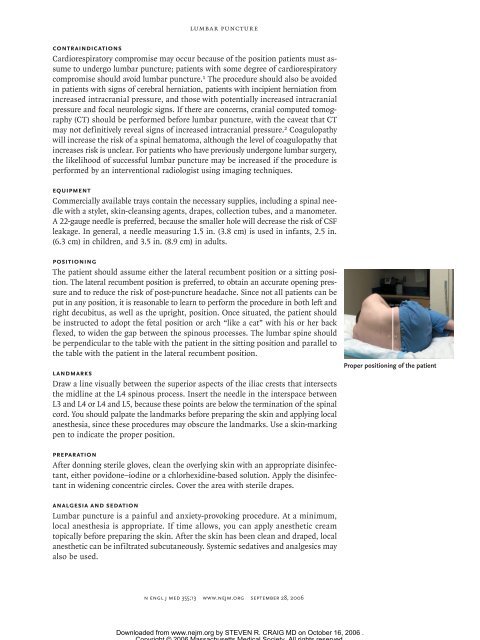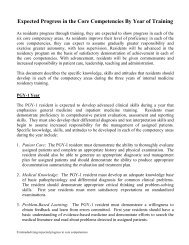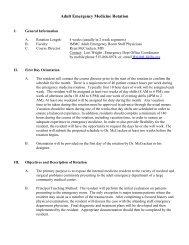Lumbar Puncture
Lumbar Puncture
Lumbar Puncture
You also want an ePaper? Increase the reach of your titles
YUMPU automatically turns print PDFs into web optimized ePapers that Google loves.
lumbar puncture<br />
Contraindications<br />
Cardiorespiratory compromise may occur because of the position patients must assume<br />
to undergo lumbar puncture; patients with some degree of cardiorespiratory<br />
compromise should avoid lumbar puncture. 1 The procedure should also be avoided<br />
in patients with signs of cerebral herniation, patients with incipient herniation from<br />
increased intracranial pressure, and those with potentially increased intracranial<br />
pressure and focal neurologic signs. If there are concerns, cranial computed tomography<br />
(CT) should be performed before lumbar puncture, with the caveat that CT<br />
may not definitively reveal signs of increased intracranial pressure. 2 Coagulopathy<br />
will increase the risk of a spinal hematoma, although the level of coagulopathy that<br />
increases risk is unclear. For patients who have previously undergone lumbar surgery,<br />
the likelihood of successful lumbar puncture may be increased if the procedure is<br />
performed by an interventional radiologist using imaging techniques.<br />
Equipment<br />
Commercially available trays contain the necessary supplies, including a spinal needle<br />
with a stylet, skin-cleansing agents, drapes, collection tubes, and a manometer.<br />
A 22-gauge needle is preferred, because the smaller hole will decrease the risk of CSF<br />
leakage. In general, a needle measuring 1.5 in. (3.8 cm) is used in infants, 2.5 in.<br />
(6.3 cm) in children, and 3.5 in. (8.9 cm) in adults.<br />
Positioning<br />
The patient should assume either the lateral recumbent position or a sitting position.<br />
The lateral recumbent position is preferred, to obtain an accurate opening pressure<br />
and to reduce the risk of post-puncture headache. Since not all patients can be<br />
put in any position, it is reasonable to learn to perform the procedure in both left and<br />
right decubitus, as well as the upright, position. Once situated, the patient should<br />
be instructed to adopt the fetal position or arch “like a cat” with his or her back<br />
flexed, to widen the gap between the spinous processes. The lumbar spine should<br />
be perpendicular to the table with the patient in the sitting position and parallel to<br />
the table with the patient in the lateral recumbent position.<br />
Landmarks<br />
Draw a line visually between the superior aspects of the iliac crests that intersects<br />
the midline at the L4 spinous process. Insert the needle in the interspace between<br />
L3 and L4 or L4 and L5, because these points are below the termination of the spinal<br />
cord. You should palpate the landmarks before preparing the skin and applying local<br />
anesthesia, since these procedures may obscure the landmarks. Use a skin-marking<br />
pen to indicate the proper position.<br />
Proper positioning of the patient<br />
Preparation<br />
After donning sterile gloves, clean the overlying skin with an appropriate disinfectant,<br />
either povidone–iodine or a chlorhexidine-based solution. Apply the disinfectant<br />
in widening concentric circles. Cover the area with sterile drapes.<br />
Analgesia and Sedation<br />
<strong>Lumbar</strong> puncture is a painful and anxiety-provoking procedure. At a minimum,<br />
local anesthesia is appropriate. If time allows, you can apply anesthetic cream<br />
topically before preparing the skin. After the skin has been clean and draped, local<br />
anesthetic can be infiltrated subcutaneously. Systemic sedatives and analgesics may<br />
also be used.<br />
n engl j med 355;13 www.nejm.org september 28, 2006<br />
Downloaded from www.nejm.org by STEVEN R. CRAIG MD on October 16, 2006 .<br />
Copyright © 2006 Massachusetts Medical Society. All rights reserved.






